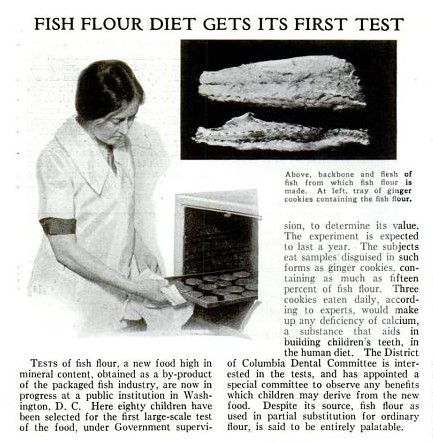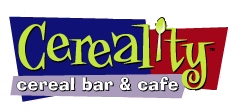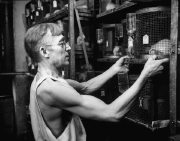Food
Pickled Herring Eating Contest
I actually enjoy pickled herring. But there is no way I will ever stand on a stage and consume mass quantities of it.Pickled Herring Eating Contest from Dave Knows on Vimeo.
Posted By: Paul - Sat Jan 24, 2009 -
Comments (1)
Category: Contests, Races and Other Competitions, Food
Johnny Lovewisdom
Johnny Lovewisdom (1919-2000) sounds like an interesting character. Some facts about his life from Wikipedia:- He was the author of The Buddhist Essene Gospel of Jesus.
- He was a long-time advocate of fruitarianism (a diet of 100% fruit).
- He tried to live solely on the papaya tree's fruit and leaves. Eventually, he started to bleed profusely as a result of developing a severe allergic reaction to papaya.
- Likely as a result of various diets, he suffered from paralysis and poor eyesight, and is thought to have had neurological problems associated with vitamin B12 deficiency.
- He lived as a hermit in the mountain crater lake, Quilotoa, in Ecuador. Lovewisdom believed that the thin air at high altitudes would allow him to develop clairvoyance and "drink alcohol like water without getting drunk."
- For a time, he ran a mail order diploma mill and signed his name followed by several degrees: N.H.D, M.D, Sc. D, Ps. D, Ph. D, D.D.
- He believed himself to be the reincarnation of Milarepa and John the Baptist.
Posted By: Alex - Tue Jan 13, 2009 -
Comments (8)
Category: Food, Nutrition
Alex’s Meat
Thanks to Stannous for sharing this picture with us. I hadn't realized I had my own meat. It's available for purchase here.
If you're looking for Chuck's Meat, it's here. And here's Paul's Meat.
Posted By: Alex - Fri Jan 09, 2009 -
Comments (7)
Category: Food
Korean Menu
Can I have a side of flesh-flesh with my house bear thang?

via engrish.com
Posted By: Alex - Tue Jan 06, 2009 -
Comments (4)
Category: Food
Fish Flour

From Popular Science, Oct 1931. A woman baking fish-flour cookies. Mmmmm.
Fish Flour is basically a powder made from ground-up fish. From the 1930s to the 1960s the fish industry pushed hard to convince people that fish flour was a) palatable, and b) a possible solution to world hunger (because of its high protein content). But I guess it never caught on. There was a last high-visibility pr effort in 1968, when U.N. officials were given fish-flour cookies as a snack, but after that fish flour fell off the map.
Posted By: Alex - Thu Jan 01, 2009 -
Comments (6)
Category: Food
Let Them Eat Camel
This was news to me: Australia has one of the largest wild camel populations in the world. There are so many camels there, that they're becoming an environmental problem. Therefore, scientists are urging Australians to control the camel population by eating more camel.According to Wikipedia, "camel meat tastes like coarse beef, but older camels can prove to be tough and less flavorful."
I'd try camel meat, but I've never seen it on sale in the States. Link: Daily Mail
Posted By: Alex - Mon Dec 22, 2008 -
Comments (11)
Category: Food
Cereality
 Cereality claims to be "an idea whose time has come." It's a cereal bar:
Cereality claims to be "an idea whose time has come." It's a cereal bar:I'm sure there must be people who think this is a great idea, but I'm not one of them. I can't imagine ever wanting to make a special trip to get a bowl of cereal. But then, I'm not a cereal fan. Every morning it's oatmeal for me.
Posted By: Alex - Wed Dec 17, 2008 -
Comments (5)
Category: Food, Restaurants
Eating Glass
The new Google magazine archive is a goldmine for weirdness. Here's another find from Popular Science, Nov 1931:Glass beads, strands of knotted thread, and even tiny pellets of gold is the diet of Frederick Hoelzel, Chicago, Ill., university student, since he offered to aid physiologists of the University of Chicago in research work on indigestion. The foreign objects are mixed with his meals, and his stomachaches come under laboratory scrutiny. They are no novelty to the subject of this unusual experiment; he volunteered for the tests because he already suffered from severe digestive troubles.
The full results of Hoelzel's glass-eating study were published in the American Journal of Physiology, (Mar 1, 1930), "The Rate of Passage of Inert Materials Through the Digestive Tract." The article includes a helpful chart, detailing exactly how long it took for various substances (including steel ball-bearings and bent silver wire) to pass through Hoelzel's system:

 Hoelzel was an interesting character. He became an expert on nutrition and often subjected himself to grueling diet experiments -- particularly experiments involving fasting for extended periods of time. The Life photo archive has a picture of him, taken in 1955. He seems to have been one of the first researchers to make a link between calorie-restriction and longevity, though it didn't really work for him. He died in 1963 at the age of 73.
Hoelzel was an interesting character. He became an expert on nutrition and often subjected himself to grueling diet experiments -- particularly experiments involving fasting for extended periods of time. The Life photo archive has a picture of him, taken in 1955. He seems to have been one of the first researchers to make a link between calorie-restriction and longevity, though it didn't really work for him. He died in 1963 at the age of 73.
Posted By: Alex - Fri Dec 12, 2008 -
Comments (8)
Category: Food, Nutrition, Science, Experiments
Sweet Dreams
See three more videos by Kirsten Lepore here.
Posted By: Paul - Sun Dec 07, 2008 -
Comments (3)
Category: Art, Surrealism, Food, Nutrition, Sexuality, Video, Cartoons
Space Beer
 In 2006 scientists grew barley on the International Space Station as part of an experiment to determine whether crops can survive in space (and one day feed astronauts living up there). They found that "the barley showed almost no ill effects from growing in microgravity or radiation. The scientists found only one enzyme increased from slight oxygen deprivation, but the plants did well." Back on Earth Sapporo recently brewed 100 bottles of "Space Beer" from the barley.
In 2006 scientists grew barley on the International Space Station as part of an experiment to determine whether crops can survive in space (and one day feed astronauts living up there). They found that "the barley showed almost no ill effects from growing in microgravity or radiation. The scientists found only one enzyme increased from slight oxygen deprivation, but the plants did well." Back on Earth Sapporo recently brewed 100 bottles of "Space Beer" from the barley.An increase of only one enzyme? This must be disappointing news to the Chinese, who for decades have been blasting seeds and sperm into space, in the theory that the combination of cosmic radiation and microgravity will produce mutations that will yield larger, stronger varieties. They even have a Center for Space Breeding. I think they've been watching too many 1950's science-fiction movies.
Back in 2007 a purple "space potato" grown from seeds taken onboard the Shenzhou IV space mission were all the rage in Shanghai restaurants. (Reportedly they tasted more "glutinous" than normal potatoes.)
And in 2005, as I've noted before, there were reports the Chinese had carried pig sperm into space, in the hope of breeding larger, tastier pigs.
Posted By: Alex - Sat Dec 06, 2008 -
Comments (0)
Category: Food, Space Travel

| Who We Are |
|---|
| Alex Boese Alex is the creator and curator of the Museum of Hoaxes. He's also the author of various weird, non-fiction, science-themed books such as Elephants on Acid and Psychedelic Apes. Paul Di Filippo Paul has been paid to put weird ideas into fictional form for over thirty years, in his career as a noted science fiction writer. He has recently begun blogging on many curious topics with three fellow writers at The Inferior 4+1. Contact Us |




